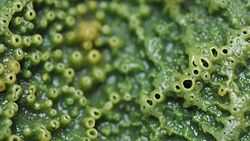Halichondria panicea
| Halichondria panicea | |
|---|---|
 | |
| Scientific classification | |
| Kingdom: | Animalia |
| Phylum: | Porifera |
| Class: | Demospongiae |
| Order: | Halichondrida |
| Family: | Halichondriidae |
| Genus: | Halichondria |
| Species: | H. panicea |
| Binomial name | |
| Halichondria panicea Pallas, 1766[1] | |
Halichondria panicea, commonly known as the breadcrumb sponge, is a species of marine demosponge belonging to the family Halichondriidae. This is an abundant sponge of coastal areas of the North Atlantic and the Mediterranean Sea ranging from the intertidal zone to a recorded depth of over 550 m. It is very tolerant of a wide range of coastal habitats, including strong currents, high salinity and exposure to powerful wave action. Its only requirement is a rocky substrate which can include small cobbles.
Morphology

Halichondria panicea occurs in a very wide range of forms and can be difficult to identify. Some forms have a granular surface which gives rise to the common name but sometimes the surface is smooth, even glassy. The surface is often marked with pores (osculae) which can extend into tubular "chimneys" in wave-sheltered habitats. The overall form is determined largely by the habitat: wave-exposed forms usually form thin widespread sheets but wave-sheltered forms often form massive encrustations up to 20 cm thick. This diversity has led to its being described as a new species 56 times.[2]
The colour is also variable. The "natural" colour is cream or grey: this is usually found in specimens from relatively deep water. However at shallower depths, the sponge is usually green due to symbiotic algae which live close to the surface of the sponge. At intermediate depths the sponge tends to be green in summer, cream or grey in winter. It smells like "exploded gunpowder".[3]
Biology
Halichondria panicea is a suspension feeder feeding mainly on phytoplankton. For such a common species, relatively little is known about its reproduction: It appears to be a hermaphrodite and oogenesis has been reported as occurring in a very narrow timeband within a single population although exceptions have been observed.
Other names[4]
- Halichondria panicea Pallas, 1766
- Halina panicea Pallas, 1766
- Spongia panicea Pallas, 1766
- Spongia tomentosa Linnaeus, 1767
- Spongia cristata Ellis & Solander, 1786
- Spongia tubulosa Ellis & Solander, 1786
- Spongia urens Ellis & Solander, 1786
- Halichondria papillaris Linnaeus, 1791
- Alcyonium manusdiaboli sensu Esper, 1794
- Spongia compacta Sowerby, 1806
- Alcyonium medullare Lamarck, 1815
- Halichondria albescens Rafinesque, 1818
- Seriatula seriata Grant, 1826
- Spongia seriata Grant, 1826
- Halichondria sevosa Johnston, 1842
- Halichondria reticulata Lieberkühn, 1859
- Halichondria coccinea Bowerbank, 1861
- Hymeniacidon coccinea Bowerbank, 1861
- Halichondria brettii Bowerbank, 1866
- Hymeniacidon brettii Bowerbank, 1866
- Hymeniacidon fallaciosus Bowerbank, 1866
- Halichondria caduca Bowerbank, 1866
- Halichondria glabra Bowerbank, 1866
- Halichondria incerta Bowerbank, 1866
- Halichondria lactea Bowerbank, 1866
- Halichondria membrana Bowerbank, 1866
- Hymeniacidon fragilis Bowerbank, 1866
- Hymeniacidon lactea Bowerbank, 1866
- Hymeniacidon membrana Bowerbank, 1866
- Hymeniacidon thomasii Bowerbank, 1866
- Hymeniacidon parfitti Parfitt, 1868
- Hymeniacidon reticulatus Bowerbank, 1866
- Pellina bibula Schmidt, 1870
- Spuma borealis var. convoluta Miklucho-Maclay, 1870
- Spuma borealis var. tuberosa Miklucho-Maclay, 1870
- Spuma borealis var. velamentosa Miklucho-Maclay, 1870
- Halichondria ambigua Bowerbank, 1874
- Halichondria edusa Bowerbank, 1874
- Halichondria firmus Bowerbank, 1874
- Halichondria pannosus Verrill, 1874
- Hymeniacidon firmus Bowerbank, 1874
- Hymeniacidon solida Bowerbank, 1874
- Hymeniacidon tegeticula Bowerbank, 1874
- Amorphina appendiculata Schmidt, 1875
- Halichondria paciscens Schmidt, 1875
- Amorphina paciscens Schmidt, 1875
- Halichondria coralloides Bowerbank, 1882
- Isodictya crassa Bowerbank, 1882
- Isodictya perplexa Bowerbank, 1882
- Microciona tumulosa Bowerbank, 1882
- Amorphina grisea Fristedt, 1887
- Halichondria grisea Fristedt, 1887
- Menanetia minchini Topsent, 1896
- Halichondriella corticata Burton, 1931
- Trachyopsilla glaberrima Burton, 1931
- Halichondria topsenti de Laubenfels, 1936
References
- ↑ Taxon page in World Porifera Database
- ↑ IPS News article
- ↑ Register clears out 'fishy' names
- ↑ http://blogs.nature.com/news/thegreatbeyond/2008/06/ocean_census_reveals_the_beast.html